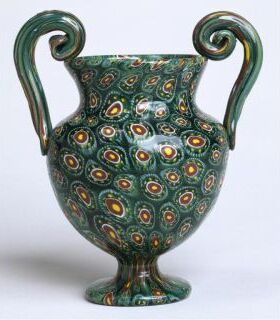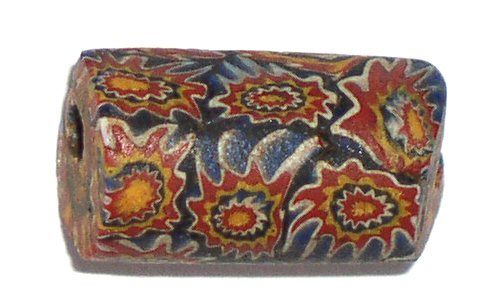Millefiori on:
[Wikipedia]
[Google]
[Amazon]

 Millefiori () is a glasswork technique which produces distinctive decorative patterns on glassware. The term millefiori is a combination of the
Millefiori () is a glasswork technique which produces distinctive decorative patterns on glassware. The term millefiori is a combination of the

 The manufacture of mosaic
The manufacture of mosaic  The technical knowledge for creating millefiori was lost by the eighteenth century, and the technique was not revived until the nineteenth century. Within several years of the technique's rediscovery, factories in
The technical knowledge for creating millefiori was lost by the eighteenth century, and the technique was not revived until the nineteenth century. Within several years of the technique's rediscovery, factories in
 The millefiori technique involves the production of glass canes or rods, known as
The millefiori technique involves the production of glass canes or rods, known as

Italian
Italian(s) may refer to:
* Anything of, from, or related to the people of Italy over the centuries
** Italians, an ethnic group or simply a citizen of the Italian Republic or Italian Kingdom
** Italian language, a Romance language
*** Regional Ita ...
words "mille" (thousand) and "fiori" (flowers). Apsley Pellatt in his book ''Curiosities of Glass Making'' was the first to use the term "millefiori", which appeared in the ''Oxford English Dictionary
The ''Oxford English Dictionary'' (''OED'') is the first and foundational historical dictionary of the English language, published by Oxford University Press (OUP). It traces the historical development of the English language, providing a com ...
'' in 1849; prior to that, the beads were called mosaic
A mosaic is a pattern or image made of small regular or irregular pieces of colored stone, glass or ceramic, held in place by plaster/mortar, and covering a surface. Mosaics are often used as floor and wall decoration, and were particularly pop ...
beads. While the use of this technique long precedes the term "millefiori", it is now most frequently associated with Venetian glass
Venetian glass () is glassware made in Venice, typically on the island of Murano near the city. Traditionally it is made with a soda–lime "metal" and is typically elaborately decorated, with various "hot" glass-forming techniques, as well as ...
ware.
Since the late 1980s, the millefiori technique has been applied to polymer clay
Polymer clay is a type of hardenable modeling clay based on the polymer polyvinyl chloride (PVC). It typically contains no clay minerals, but like mineral clay a liquid is added to dry particles until it achieves gel-like working properties, and s ...
and other materials. As the polymer clay is quite pliable and does not need to be heated and reheated to fuse it, it is a much easier medium in which to produce millefiori patterns than glass.
History
 The manufacture of mosaic
The manufacture of mosaic bead
A bead is a small, decorative object that is formed in a variety of shapes and sizes of a material such as stone, bone, shell, glass, plastic, wood, or pearl and with a small hole for threading or stringing. Beads range in size from under ...
s can be traced to Ancient Roman, Phoenicia
Phoenicia () was an ancient thalassocratic civilization originating in the Levant region of the eastern Mediterranean, primarily located in modern Lebanon. The territory of the Phoenician city-states extended and shrank throughout their histor ...
n and Alexandrian times. Canes
Cane or caning may refer to:
*Walking stick or walking cane, a device used primarily to aid walking
*Assistive cane, a walking stick used as a mobility aid for better balance
*White cane, a mobility or safety device used by many people who are b ...
, probably made in Italy, have been found as far away as 8th century archaeological sites in Ireland. Millefiori beads have been uncovered from digs at Sandby borg, Öland, Sweden, dating apparently from the late 5th or early 6th century.Alfsdotter, C., Papmehl-Dufay, L., & Victor, H. (2018). A moment frozen in time: Evidence of a late fifth-century massacre at Sandby borg. Antiquity, 92(362), 421-436. doi:10.15184/aqy.2018.21 A piece of millefiori was found, along with unworked garnets, in a purse at the early 7th century Anglo-Saxon burial site at Sutton Hoo
Sutton Hoo is the site of two early medieval cemeteries dating from the 6th to 7th centuries near the English town of Woodbridge. Archaeologists have been excavating the area since 1938, when a previously undisturbed ship burial containing a ...
.
 The technical knowledge for creating millefiori was lost by the eighteenth century, and the technique was not revived until the nineteenth century. Within several years of the technique's rediscovery, factories in
The technical knowledge for creating millefiori was lost by the eighteenth century, and the technique was not revived until the nineteenth century. Within several years of the technique's rediscovery, factories in Italy
Italy ( it, Italia ), officially the Italian Republic, ) or the Republic of Italy, is a country in Southern Europe. It is located in the middle of the Mediterranean Sea, and its territory largely coincides with the homonymous geographical re ...
, France
France (), officially the French Republic ( ), is a country primarily located in Western Europe. It also comprises of Overseas France, overseas regions and territories in the Americas and the Atlantic Ocean, Atlantic, Pacific Ocean, Pac ...
and England
England is a country that is part of the United Kingdom. It shares land borders with Wales to its west and Scotland to its north. The Irish Sea lies northwest and the Celtic Sea to the southwest. It is separated from continental Europe b ...
were manufacturing millefiori canes. They were often incorporated into fine glass art paperweights
A paperweight is a small solid object heavy enough, when placed on top of papers, to keep them from blowing away in a breeze or from moving under the strokes of a painting brush (as with Chinese calligraphy). While any object, such as a stone, ...
.
Until the 15th century, Murano glass
Venetian glass () is glassware made in Venice, typically on the island of Murano near the city. Traditionally it is made with a soda–lime "metal" and is typically elaborately decorated, with various "hot" glass-forming techniques, as well as ...
makers were only producing drawn Rosetta beads made from molded
Molding (American English) or moulding (British and Commonwealth English; see spelling differences) is the process of manufacturing by shaping liquid or pliable raw material using a rigid frame called a mold or matrix. This itself may have ...
Rosetta canes. Rosetta beads are made by the layering of a variable number of layers of glass of various colors in a mold, and by pulling the soft glass from both ends until the cane has reached the desired thickness. It is then cut into short segments for further processing.
Production
 The millefiori technique involves the production of glass canes or rods, known as
The millefiori technique involves the production of glass canes or rods, known as murrine
Murrine (singular: murrina) are colored patterns or images made in a glass cane that are revealed when the cane is cut into thin cross-sections. Murrine can be made in infinite designs from simple circular or square patterns to complex detailed ...
, with multicolored patterns which are viewable only from the cut ends of the cane. A murrine rod is heated in a furnace and pulled until thin while still maintaining the cross section's design. It is then cut into beads or discs when cooled.
See also
*Mille-fleur
Millefleur, millefleurs or mille-fleur ( French mille-fleurs, literally "thousand flowers") refers to a background style of many different small flowers and plants, usually shown on a green ground, as though growing in grass. It is essentially re ...
, a French term used to refer to a background composed of small flowers
* Venetian beads
*Trade beads
Trade beads are beads that were used as a medium of barter within and amongst communities. They are considered to be one of the earliest forms of trade between members of the human race. It has also been surmised that bead trading was one of t ...
for the use of millefiori beads in the slave trade
*Glass museums and galleries
Glass is a non-crystalline, often transparent, amorphous solid that has widespread practical, technological, and decorative use in, for example, window panes, tableware, and optics. Glass is most often formed by rapid cooling (quenching) of ...
*Murrine
Murrine (singular: murrina) are colored patterns or images made in a glass cane that are revealed when the cane is cut into thin cross-sections. Murrine can be made in infinite designs from simple circular or square patterns to complex detailed ...
References
External links
* {{Authority control Glass art Beadwork Glass production Italian words and phrases